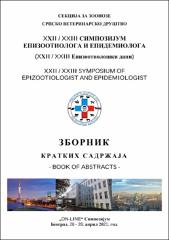| dc.contributor.author | Ilić, Tamara | |
| dc.contributor.author | Petrović, Tamaš | |
| dc.contributor.author | Stepanović, Predrag | |
| dc.contributor.author | Bogunović, Danica | |
| dc.contributor.author | Gajić, Bojan | |
| dc.contributor.author | Kulišić, Zoran | |
| dc.contributor.author | Ristić, Marko | |
| dc.contributor.author | Hadži Milić, Milan | |
| dc.contributor.author | Dimitrijević, Sanda | |
| dc.date.accessioned | 2021-06-25T11:41:56Z | |
| dc.date.available | 2021-06-25T11:41:56Z | |
| dc.date.issued | 2021-04-26 | |
| dc.identifier.isbn | 978-86-83115-41-9 | |
| dc.identifier.uri | https://repo.niv.ns.ac.rs/xmlui/handle/123456789/376 | |
| dc.description.abstract | The paper presents a retrospective report and a summary of the research conducted under the TR31084 project in the period 2015-2020. The study aims to point to an increase in the prevalence of nematodes with zoonotic potential in domestic and wild carnivores in Serbia. The presented epizootiological situation arose as a result of global warming and active migration of owners with their pets to countries in the region and Europe, many of which already represent endemic areas of diagnosed pathogens. These factors have led to an increase in the prevalence of certain cardiorespiratory, ocular and intestinal parasitoses, some of which have also become endemic in Serbia. The population of domestic carnivores surveyed (owner dogs and cats, service dogs and shelter dogs) was diagnosed with the highest prevalence of Dirofilaria immitis (68.00%) in service dogs from Belgrade and Thelazia callipaeda (47.50%) in owner dogs from Bor district. Of the intestinal nematodes, the most frequent were Toxocara canis (42.85%) in dogs from the shelter in Zemun and Dipylidium caninum (21.49 - 24.70%) in owner cats and dogs from the territory of the City of Belgrade. In the wild carnivores (foxes and jackals) examined, the presence of the respiratory nematode Capillaria aerophila (74.04%) was dominated by foxes from the Zaječar district. Toxarosis of foxes (84.05%) and ancylostomatidosis of jackals (40.90%) were the most frequent intestinal nematodes of wild carnivores in the Republic of Serbia, covered by parasitological screening. Urbanization of cities in Serbia has led to the expansion of the urban belt to the peripheral parts of the city and to the cottage settlements, which until recently were occupied only by foxes. With the widening of the city belt, close contact of stray dogs and owner's backyard dogs is handcuffed. The result of such contact is a significant alteration of the parasitofauna of dogs, so that they become a source of new pathogens, which later through their gastrointestinal tract eliminate to public areas and are a source of infection for the human population. In Serbia, as in many European countries, vaccination of foxes against rabies (through bait) is legally regulated. As a result, rabies has been brought under control, but the number of foxes has increased, and therefore the prevalence of parasites for which foxes are sources / reservoirs of infection. This is just an additional factor in the chain: fox - stray dog - owner dog - human, significantly increases the risk and the tendency for humans to become infected with intestinal parasites of wild and domestic carnivores.
Keywords: carnivores, parasitological | en_US |
| dc.description.sponsorship | The study was supported by the Ministry of Education, Science and Technological Development of the Republic of Serbia (Contract number 451-03-9/2021-14/200143). | en_US |
| dc.language.iso | other | en_US |
| dc.publisher | SVD, Sekcija za zoonoze, Beograd (Srbija) | en_US |
| dc.source | Zbornik kratkih sadržaja, XXII/XXIII Simpozijum epizootiologa i epidemiologa (XXII/XXIII Epizootiološki dani), on-line, Beograd | sr |
| dc.subject | carnivores | en_US |
| dc.subject | parasitological screening | en_US |
| dc.subject | zoonoses | en_US |
| dc.subject | endemic parasitoses | en_US |
| dc.subject | Serbia | en_US |
| dc.title | Epizootiološka situacija važnijih zoonoznih helmintoza domaćih i divljih mesojeda u Srbiji | en_US |
| dc.title.alternative | Epizootiological situation of more important zoonotic helminthoses of domestic and wild carnivores in Serbia | en_US |
| dc.title.alternative | | en_US |
| dc.type | Article | en_US |

